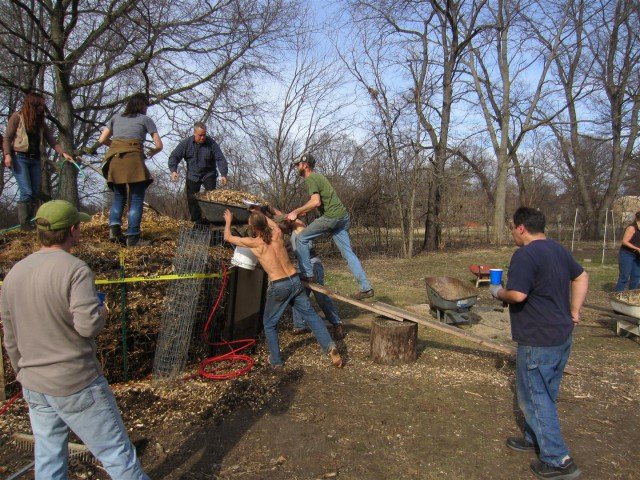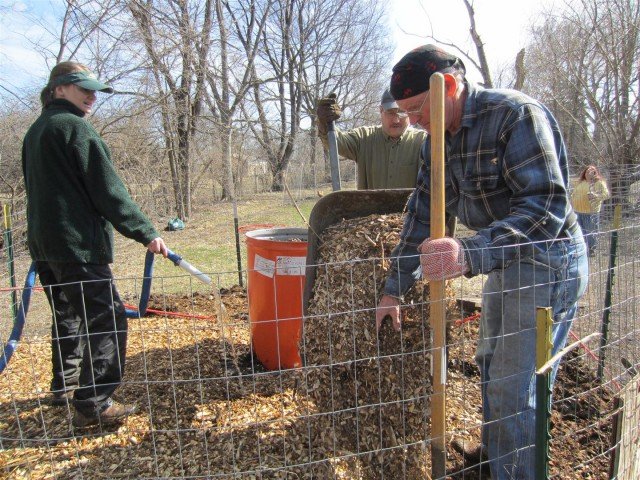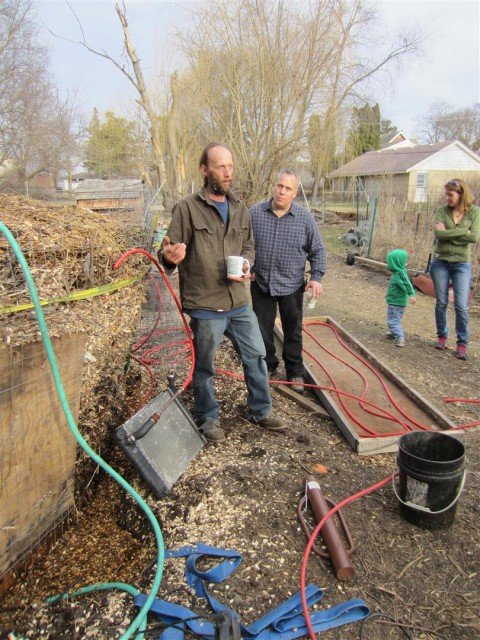Building a Jean Pain Style Compost Pile
- Milton Dixon
This past Sunday the Chicagoland Permaculture Meetup and Living Off The Grid Meetup joined forces to build a compost pile that would provide heat for the grow beds of a greenhouse.

First we cleared away the remains of last years compost pile, pulling out the hose to reuse in the new pile and spreading the compost on the garden.

Then we measured out a radius of 7′ and began depositing the wood chips and horse manure, all the while embedding nearly 300′ of pipe spiraling throughout, and a 55 gallon container in the middle to produce methane (that’s a whole other story).

We added many gallons of water with each layer to provide moisture for the bacteria that will break down the pile and generate heat.

The resulting pile was nearly 5′ in height, you can see the layers of wood chips and manure within.


Once the pile begins to heat up, a pump will move the heated water into a yet to be built hoop house, heating grow beds inside, and will keep the temperature nice and warm for starting seeds.

If you’re interested in more information, you can see the original inspiration for this project on YouTube: Jean Pain part 1 & part 2. Jean Pain extracted hot water from his 18′ diameter, 9ft high pile for 18 months. In the picture below you can see Jean, his methane storage tubes in foreground and the compost pile in the background. Peter Bane of the Permaculture Activist has also written a great article on Jean.

Another example is of Darren Doherty using a similar idea to make a compost heated shower.

11 thoughts on “Building a Jean Pain Style Compost Pile”
Jean Pain’s book “Another Kind of Garden” is available for download as a PDF file:
http://permaculturenews.org/2011/12/15/the-jean-pain-way/
http://files.uniteddiversity.com/Permaculture/Another_Kind_of_Garden-The_Methods_of_Jean_Pain.pdf
How was the compost pile aerated?
Hi there, we did build about 60 compost heaps the past three years with and without workshops and gained a lot of experiance with this methodology. We now offering 2 workshops in Canada and the US, September 2013. Please have a look at our YouTube videos and webside native-power.de
The compost heap can be isolated from each side but not from the top due to biochemical process the bacteria need day light and oxygen from the top. We also use a mixture of any cow, chicken or horse manure and slurry to gain more humus.
Heiner
@Heiner Cuhls
Have you had any of your piles catch on fire?
What is the largest compost pile that you can make that doesn’t spontaneously combust?
It’s possible, large municipal wood chip piles have spontaneously combust but I’ve never seen it happen.
Would there be any advantage to insulate the soil surface with, say, bags filled with pine needles or even just a tarp to keep as much heat from being lost as possible?
I think the wood chips themselves would act as enough of an insulator all around. It’s a good to be aware of that interaction, though.
Why not just dig a hole the same size and depth as an above-ground pile, thus saving the labor of piling it even higher (like Jean Pain’s 8 foot high), and also perhaps requiring less water (since the ground will supply and/or retain it) and maybe allowing it to be located adjacent to a green/hoop house, thus shortening the lines and making the structural supporting system unnecessary and reducing the winter heat loss from the “pile”(if it gets too hot I think the heating system will act as a cooling system, just like the radiator of a car. Let me know what you think.
Hi Peter…
This should certainly work. I’ve heard it referred to as ‘pit composting’. You do have the work of course of digging the hole to begin with(a great idea if you can use the soil to build hugelkulur beds someplace else) and then digging out the compost when you are done if you wish to use it else where. Then again, you may have just invented the perfect long-term gardening system since once the hole is completely full, or above the surrounding ground, maybe you could plant right into that as a raised bed. Sure would hold a lot of water.
Heard from Frank again with these further comments:
Bill,
The three levels of tubing in Jerome’s greenhouses are placed at one foot, two feet and three feet below the surface of the beds. Here is how it has been explained to me: When the water vapor in the air is drawn underground, it rapidly cools and goes through a “phase change” where the water vapor condenses into liquid water. It that process it releases a lot of heat. This heated, condensed water spills out through the holes in the plastic tubing and into the soil. Jerome has said he hopes to get 60-70 degree soil temperatures. Apparently warm soil is more important than warm air for growing plants in the greenhouse. Dispersed throughtout the large mass of soil, I don’t think it gets hot enough to cook your crops while they’re still in the ground. Imagine growing baked potatoes!
While the air temperatures in the Oregon greenhouse in August were above 100 degrees, the cool air coming out of the ends of the undeground tubes was 50 degrees and felt like air conditioning. It’s sometimes referred to as a SHCS – Subterranean Heating and Cooling System. http://www.sunnyjohn.com/indexpages/shcs.htm
Frank
the problem with pit composting is that some thought would have be put into providing air to all parts of the compost. the heat observed in a pile like this is the result of aerobic microbes. pit composting with out air ventilation with be achieved by the work of anerobic microbes that do not need breath. their the ones that put out nasty smells.
We heard from a friend of ours out west and thought you all might appreciate the info and links.
____________________________________________
Hi Bill,
Thanks for sharing this information on the thermal compost-heated greenhouse. You’re probaly aware of Jerome’s “climate battery” greenhouse at Central Rocky Mountain Permaculture Institute (CRMPI). Go to http://www.crmpi.org to see a new video on it. In 2010 I worked at a greenhouse in Oregon and another outside St. Louis last year that used Jerome’s system. The geo/solar system in each produced about 75% of the necessary energy to grow crops year round. The St. Louis greenhouse (which grew figs and tomatoes) had a back up furnance that burned waste cooking oil. The owner knew precisely how many BTUs it burned during the cold winter months. We calculated that a windrow of thermal compost, 3’X3′ running the length of the greenhouse would supply an equivalent amount of BTUs during the same cold period. If you combine these two very sustainable systems, you can probably completely heat a greenhouse to grow even warm season crops year round. (at least if you’re far enough south to have sufficient light in January). The New Alchemy Institute in the 1980s experimented with a similar thermal compost heated greenhouse: http://www.builditsolar.com/Projects/Sunspace/NewAlchemycompost.pdf. I’m hoping to build a greenhouse here in Colorado that incorporates both methods. Either system by itself works pretty well, combined they might be spectacular. I’ll keep you posted. Thanks for the inspiring posting.
Best,
Frank